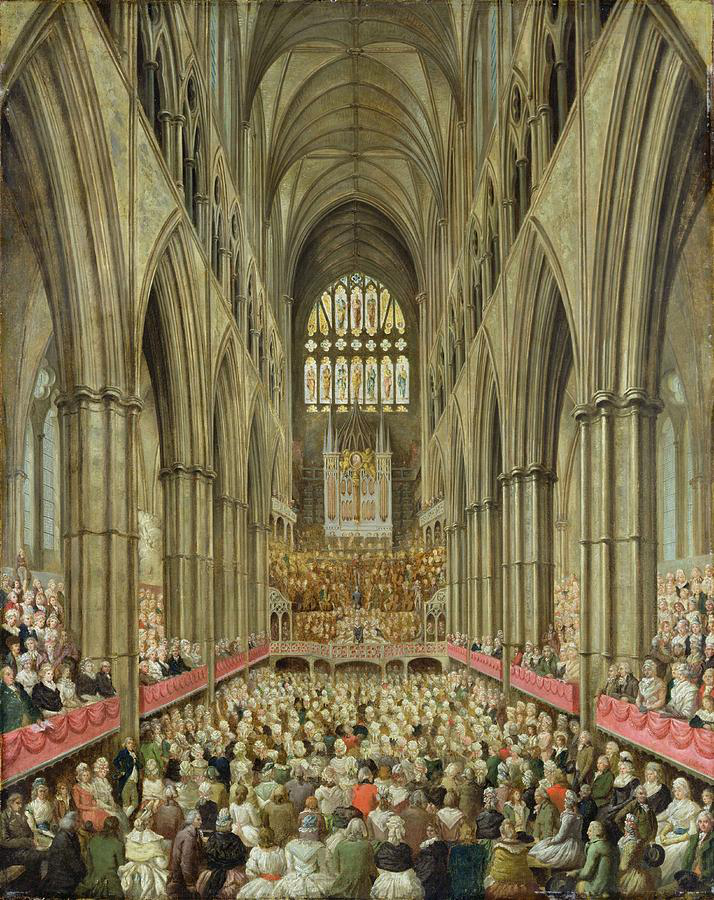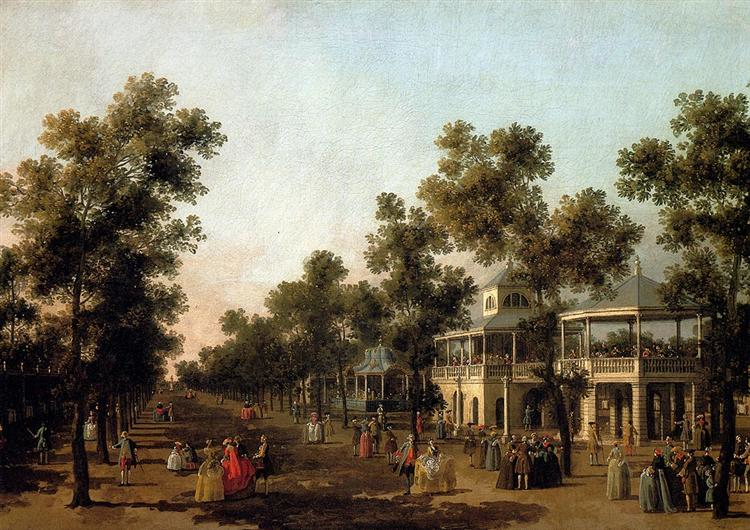Concert Spaces and Attendance
While the 18th century was an epicenter of concert activity, these concerts did not always take place in perfectly organized concert hall spaces, as we have discussed above. They often were run in taverns, coffeehouses, or anywhere that space allowed, for instance in the Devil’s Tavern at Temple Bar in London, which was one of the most popular concert sites1. The Academy of Ancient Music met fortnightly at the Crown and Anchor Tavern in the Strand and then later in Freemasons’ Hall2. As early as 1678 and all the way through 1714, Thomas Britton, known as the “musical small-coal man”3 ran a series in a loft above his shop in Clerkenwell. These concerts were highly attended and were offered at an extremely low price, which allowed a greater range of society to attend4. Higher-class patrons of the arts curated subscription series as well. Mrs. Teresa Cornelys, who was an opera singer that became a society queen, set up a subscription series in her mansion called “The Society”, which was specifically started to show off the kind of society that she was able to attract5. This series, which began in 1760, had twelve gatherings throughout the year and was criticized for being more “opulent luxury than rational elegance”6. The order of the gatherings were described in a diary by Count Frederick Kielmansegge on his travels in England that, “The vocal and instrumental music, by an orchestra at the end of the room, begins at seven o’clock and lasts until nine’ dancing afterwards goes on until one or two.”7
Though of course audience capacity depended on the amount of space available at any given concert venue, the amount of subscribers was often much higher than one might expect. From the 1760’s to the early 1790’s it was standard to have subscriptions of around 500 per series per year and an attendance of 300 to 500 per concert, but sometimes the attendance could reach 600 or higher8, depending on the series and the venue. Considering the amount of concerts happening on any given night, the population of upper-class people living in England at the time, this high number is quite extraordinary. It further suggests the societal importance of attending and being publicly seen at concerts.
However, the number of concert attendees at regular subscription series does not come close to the number that attended the previously mentioned Handel Centenary Celebration that took place first on the 26th, 27th and 29th of May in 1784 with reprises in 1785-7 and 1790-1. An audience of around 3,000 people attended the concerts9, first in Westminster Abbey midday, then the next evening at the Pantheon with selections of Handel’s instrumental and vocal music, and finally the next morning with a performance of the Messiah10. The concerts were directed by the Academy of Ancient Music with great numbers of players, and, even more extraordinary than the number of audience and players was the rapt silence from the entire audience throughout the performance, an anomaly that we will discuss more later. Charles Burney wrote in his Account of the Musical Performances…in Commemoration of Handel,
But, in justice to the audience, it may be said, that though the frequency of hearing good Music in this capital, of late years, has so far blunted the edge of curiosity and appetite, that the best Operas and Concerts are accompanied with a buz[sic] and murmur of conversation, equal to that of a tumultuous croud[sic], or the din of high ‘Change; yet now, such a stillness reigned, as, perhaps, never happened before in so large an assembly. The midnight hour was never sounded in more perfect tranquillity[sic], than every note of these compositions.11
The astonishing growth of audience in public concerts naturally coincided with the development of larger scale symphonic repertoire being performed. These evenings were looked forward to as a chance to get to hear favorite musicians play with larger orchestras. On the occasion of attending a concert, a society lady named Mrs. Papendiek wrote,
The wished-for night at length arrived, and as I was anxious to be near the performers I went early. Mr. Papendiek followed from Queen’s House, and I got an excellent seat on a sofa at the right-hand side. The orchestra was arranged on a new plan. The pianoforte was in the centre, at each extreme end the double basses, then on each side two violoncellos, then two tenors or violas and two violins, and in the hollow of the piano a desk on a high platform for Salomon and his ripieno. At the back, verging down to a point at each end, all these instruments were doubled, giving the requisite number for a full orchestra. Still further back, raised high up, were drums, and [on the] other side the trumpets, trombones, bassoons, oboes, clarinets, flutes, &c., in numbers according to the requirements of the symphonies and other music to be played on the different evenings.12
There are many clues about the concert experience that we get from what Mrs. Papendiek wrote. First, the seating was not reserved and there were sofas and couches and other types of seats available, creating a less-formal atmosphere than matching chairs in rows. The second is that Mrs. Papendiek was aware of the standard set-up and numbers for an orchestra and remarked on the growth and new set up that must have been moved around in order to make certain instruments more clearly heard. In this particular performance, Haydn was conducting everything, even the pieces played by other composers, and the concert took place in the Hanover Square Rooms, which were originally established to be a space for musical performances. Mrs. Papendiek goes on to describe the halls and the attendance of the concert:
Hanover Square Rooms are calculated to hold 800 persons exclusive of the performers. By the beginning of the second act we concluded that all had arrived who intended to come, and though we knew that Salomon’s subscription list was not full, we had hoped for additions during the evening. But no; and I regret to make this observation of my countrymen, that until they know what value they are likely to receive for their money they are slow in coming forward with it…13
While Mrs. Papendiek laments the lack of full concert capacity as owing to not wanting to pay money for something which is of unknown quality, it also could have had to do with a general trend of change happening at the end of the 18th century with the development of larger symphonies. The public loved these and in turn they brought larger and therefore more diverse audiences, and the upper class reacted to this in multiple ways. Since the upper classes were interested in being seen with the right people in the right places, they were less than enthusiastic as more and more people had access to the public concert sphere. Some began to turn more to private soirees so as to keep the exclusivity they desired14. Some became more involved in the Academy of Ancient Music and other spheres of musical performances.
In some places, however, the wide range of audience was expected, one of these being the pleasure gardens. Vauxhall Gardens was a very popular place to enjoy music and company in a beautiful outdoor space. They were open to all classes and considered the “most elaborate of London’s pleasure gardens”15. Haydn attended a celebration for the king’s birthday at Vauxhall Gardens and wrote that,
Over 30,000 lamps were burning, but because of the severe cold there were very few people present. The grounds and its variety are perhaps unique in the world. There are 155 little dining booths in various places, most charmingly situated, each comfortably seating 6 persons. There are very large alleys of trees, which form a wonderful roof above, and are magnificently illuminated. Tea, coffee, and milk with almonds all cost nothing. The entrance fee is half a crown per person. The music is fairly good. A stone statue of Handel has been erected. On the 2nd inst. there was a masked ball, and on this evening they took in 3000 guineas.16
Another more topographically detailed description of Vauxhall comes from Pastor Charles Moritz who wrote a travel journal while journeying through England.
This orchestra is among a number of trees situated as in a little wood, and is an exceedingly handsome one. As you enter the garden, you immediately hear the sound of vocal and instrumental music. There are several female singers constantly hired here to sing in public. On each side of the orchestra are small boxes, with tables and benches, in which you sup. The walks before these, as well as in every other part of the garden, are crowded with people of all ranks…but what most astonished me, was the boldness of the women of the town; who, along with their pimps, often rushed in upon us by half dozens; and in the most shameless manner importuned us for wine, for themselves and their followers. 17
Both Pastor Moritz and Haydn comment on the spectacle of the space, how charming and beautiful it was, the food and drink, as well as the range of audience members. Moritz, as a traveling outsider, was surprised and somewhat uncomfortable with the social mixing of the audience members of different classes. What an experience it must have been to be in an outdoor concert with beautiful music and the social scene gathered there.

